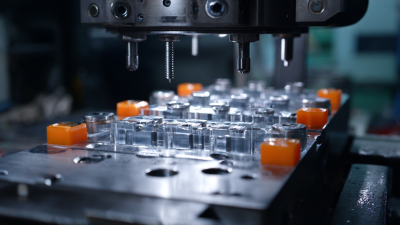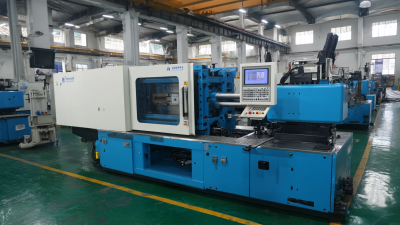The Ultimate Guide to Choosing the Best Mold Materials for Injection Molding Success
In the competitive landscape of manufacturing, the choice of mold material for injection molding can significantly influence the success of production outcomes. According to a report by Grand View Research, the global injection molding market size was valued at USD 288.3 billion in 2020 and is expected to expand at a CAGR of 5.0% from 2021 to 2028, highlighting the increasing demand for efficient and high-quality molded parts. The right mold material not only affects the durability and performance of the molds but also impacts the overall production costs and cycle times.

Key Factors to Consider When Selecting Mold Materials for Injection Molding
When designing an injection mold for a car door inner panel, selecting the right mold materials is crucial for achieving both efficiency and product quality. The properties of the mold material directly impact the molding process and the final product's performance. Factors such as thermal conductivity, hardness, and resistance to wear and corrosion must be evaluated carefully. Optimal mold materials not only enhance the longevity of the mold but also improve the consistency of the injection molding process.
Tips for selecting mold materials include prioritizing materials with high thermal conductivity, as this helps maintain stable temperatures during the injection process. Additionally, consider the expected production volume; for large-scale production, materials with higher durability and lower maintenance requirements can lead to significant cost savings. It’s also vital to conduct numerical simulations of the injection molding process to identify any potential issues with the mold design or material choice before full-scale production begins.
Furthermore, optimizing process parameters such as injection speed, pressure, and cooling time can significantly affect the quality of the final inner panel. Utilizing simulation software can help ascertain the best settings that minimize defects and ensure that the panel meets the required specifications. By focusing on these key factors and employing effective simulation and optimization techniques, manufacturers can achieve successful outcomes in car door inner panel production.
The Ultimate Guide to Choosing Mold Materials for Injection Molding Success
This chart illustrates the key factors to consider when selecting mold materials for injection molding, measured in terms of their importance on a scale from 1 to 10.
Comparing Common Mold Materials: Pros and Cons for Optimal Performance
When selecting mold materials for injection molding, understanding the pros and cons of common options is crucial for achieving optimal performance.
Steel and aluminum are two of the most widely used materials. Steel molds are renowned for their durability and ability to withstand high production volumes, making them ideal for large-scale operations. However, they can be more expensive and longer to manufacture. On the other hand, aluminum molds are lighter and have quicker lead times, but they may not hold up as well under extreme wear.
Tip: Consider the production volume and part complexity when choosing your mold material. If you anticipate high quantities, investing in steel might save costs in the long run despite the initial expense.
Additionally, there are specialized materials like Beryllium Copper, which offers excellent thermal conductivity, making it suitable for intricate designs requiring precise temperature control. The trade-off, however, is its higher cost and somewhat more complex machining requirements.
Tip: Always evaluate the cooling requirements of your design. A well-cooled mold not only improves the cycle time but also enhances the quality of the finished product.
How to Assess the Cost-Effectiveness of Different Mold Materials
When evaluating the cost-effectiveness of different mold materials for injection molding, it is crucial to consider not only the initial investment but also the long-term efficiencies and sustainability outcomes. Recent studies emphasize the importance of using advanced materials that significantly reduce energy consumption and enhance product durability. For instance, the integration of post-industrial recycled glass fiber reinforced polyphenylene sulfide (PPS GF40) has demonstrated viable industrial feasibility, achieving a blend of performance and environmental benefits. This allows manufacturers to align their operational practices with sustainability goals while maintaining competitive production costs.
In the evolving landscape of mold materials, bio-based alternatives and innovative methodologies are gaining traction. For example, employing alkyl ketene dimer (AKD) for hydrophobic treatment of bio-based thermal insulation materials provides an eco-friendly and economical solution, enhancing their performance in various applications. Moreover, technologies such as 3D printing of sand molds are revolutionizing the production process, offering flexibility and reducing material waste. As these methodologies and materials continue to advance, companies must assess not only the upfront costs but also the potential for savings in energy and raw material expenses in their long-term operational strategies.

Understanding the Impact of Material Selection on Product Quality and Longevity
When selecting mold materials for injection molding, understanding the impact of material selection on product quality and longevity is paramount. According to a recent report, the potential benefits of extending product lifespans in Europe could positively influence both the economy and societal well-being. A study highlighted that products designed for longevity not only reduce waste but can also lead to improved customer satisfaction and loyalty. This aligns with consumers' increasing preference for sustainable products, as evidenced by a joint study that revealed a significant sales growth for items marketed as environmentally and socially responsible.
Moreover, the exploration of innovative materials is crucial in achieving sustainability goals within manufacturing. Research indicates that bioplastics, which generally exhibit a lower environmental burden than traditional materials, can enhance biodegradability and reduce carbon footprints during their life cycles. Similarly, the movement towards adopting natural fiber composites, derived from renewable resources, illustrates the industry’s shift towards eco-friendly alternatives. This strategic material selection not only bolsters product durability but also aligns with the principles of the circular economy, thus paving the way for more sustainable business practices in the injection molding industry.
The Ultimate Guide to Choosing the Best Mold Materials for Injection Molding Success
| Material Type | Application | Durability | Cost | Heat Resistance | Typical Lifespan |
|---|---|---|---|---|---|
| Steel | High-precision parts | Excellent | High | High | Up to 1 million cycles |
| Aluminum | Low to mid-volume production | Good | Medium | Medium | 500,000 cycles |
| P20 Steel | General purpose applications | Very Good | Medium-High | High | 300,000 cycles |
| Nylon | Flexible parts | Fair | Low | Medium | 100,000 cycles |
| Copper | Heat-exchanging parts | Excellent | High | Medium | 200,000 cycles |
Tips for Making the Right Choice: Material Selection Checklist for Success
When it comes to achieving success in injection molding, selecting the right mold materials is crucial. A well-thought-out material selection checklist can make all the difference in the performance and longevity of your molds. Start by considering the physical properties required for your specific application. Factors such as temperature resistance, durability, and corrosion resistance should be top priorities. For instance, if your product will be exposed to high temperatures, materials like high-grade steel or aluminum with enhanced thermal stability should be considered.

Next, evaluate the environmental factors that may impact mold performance. Assess the production volume and cycle times, as these will influence the wear and tear on your materials. Additionally, consider the potential for chemical exposure based on the plastics being processed. Using corrosion-resistant materials can minimize maintenance and prolong the lifespan of your molds. Lastly, ensure you factor in cost versus performance. While it may be tempting to opt for cheaper materials, investing in high-quality options can lead to better efficiency and reduced delays in the long run.
Related Posts
-

What Are the Essential Components of Plastic Injection Machine Parts?
-

5 Reasons Insert Molding is Revolutionizing Modern Manufacturing
-

Unlocking Efficiency: The Advantages of Advanced Plastic Injection Molding Machines for Global Buyers
-

Exploring Alternative Methods to Automotive Injection Molding for Efficient Production
-

How to Enhance Your Plastic Injection Molding Process for Maximum Efficiency
-

Top 7 Import Export Certifications for Best Plastic Injection Molding Machines in 2023
Submit a quote request or book a design consultation
Plastimold Products is an end-to-end product development and manufacturing team. We provide product design, engineering, prototyping, tooling, plastic injection molding, assembly, packaging and fulfillment. We work with any size company from start-ups to enterprises from all around the world.
I have a product I want to manufacture
I have a product that is already designed and now needs to be manufactured.
I need a manufacturer to optimize my product for injection molding, help choose the correct material, and manage the product production.
I have tooling that I want to transfer or modify, or I need to produce new tooling.
I need design and engineering support
I have a product concept that I want to be designed and brought to market.
I have a product that needs to be reviewed, improved or DFM’ed.
I am looking for a manufacturer to provide an end-to-end solution, from design and development to inventory, marketing, and sales.
©2022 Plastimold Products - Privacy policy - Terms and Conditions

